The Mineral Composition and Sources of the Fine-Grained Sediments from the 49.6?E Hydrothermal Field at the SWIR
ZHANG Wenqiang, SUN Xiaoxia, *, FAN Dejiang, 2), *, LIU Ming, JIA Qi, and YANG Zuosheng
The Mineral Composition and Sources of the Fine-Grained Sediments from the 49.6?E Hydrothermal Field at the SWIR
ZHANG Wenqiang1), SUN Xiaoxia1), *, FAN Dejiang1), 2), *, LIU Ming1), JIA Qi1), and YANG Zuosheng1)
1),,,266100,2),,266061,
We used the X-ray diffraction method to determine systematically the mineral phases in bulk sediment samples and acid undissolved residuals of the fine-grained fraction of the surface sediments from the 49.6?E hydrothermal field at the Southwest Indian Ridge (SWIR) and discussed the mineral sources of the surface sediments. The results showed that the surface sediments in this region were composed of calcareous ooze, and calcite was the dominant mineral. The sediments also contained quartz, feldspar, clay minerals, pyroxene, sphalerite, barite, serpentine, and magnetite. The quartz, feldspar, and clay minerals were exogenous minerals that mainly originated from the Namib and Kalahari deserts in southern Africa. The pyroxene, serpentine, magnetite, sphalerite, calcite, and barite were endogenous minerals from weathering of seafloor basement rocks and seafloor hydrothermal activities. The sulfide particles in the sediments were mainly deposited from upwelling plumes.
Southwest Indian Ridge; surface sediment; mineral; source; hydrothermal
1 Introduction
Since the Soviet researcher Skornyakova first proposed the concept of polymetallic deposits related to hydrothermal activities in 1964, researchers have focused on seafloor polymetallic deposits to conduct studies on their mineralogy, geochemistry, and genesis, and discover sulfide minerals in polymetallic deposits (Bach, 2002; Dias and Barriga, 2006; Hrischeva and Scott, 2007). Researchers have also attempted to use the sulfide typomorphic features and mineral assemblages in hydrothermal deposits to infer the temperature of the hydrothermal fluid (Dias and Barriga, 2006) and to reconstruct the history and intensity of hydrothermal activities (Fouquet and Rona, 1993; Lalou., 1995; Shilov., 2012). Since the discovery of seafloor hydrothermal activities, researches have focused on hydrothermal fluids and hydrothermal sulfides (Toner., 2009; Zhang., 2011; James., 2014), but few studies have examined hydrothermal sediments. Studies on hydrothermal sediments have been intensified since 2011 and hydrothermal minerals and seafloor rare-earth Minerals in these sediments have been discussed (Hannington., 2011; Kato., 2011; Meylan., 2012; Laurila., 2014; Riley and Chester, 2016), as well as the relationships between hydrothermal activities, ferromanganese crusts, and hydrothermal microorganisms (Dekov., 2003; Moriyama., 2011; Tao., 2012).
The South West Indian Ridge (SWIR) is a famous ultra-slow spreading ridge. Recent studies have found that along the ridge developed widespread seafloor hydrother- mal activities and might have formed large hydrothermal sulfide deposits (Beaulieu., 2015). Studies on the hy- drothermal deposits in this region have been increasing in recent years (Han., 2015; Huang., 2016; Li., 2016; Jia., 2017). Providing scientific evidences to support the exploration for hydrothermal sulfide deposits in this region through studies of metalliferous sediments has become an important issue for researchers. However, works about the sources and origins of minerals in sediments from SWIR are few. Thus, this study selected 7 surface sediment samples from the 49.6?E hydrothermal field (Dragon Flag) in the southwest Indian Ocean, and conducted a systematic mineralogical analysis to the fine-grained fraction (<0.063mm). The mineral composition was determined, and the origin of the minerals were discussed to provide a reference for the exploration of hydrothermal sulfide deposits and to better understand the characteristics of the seafloor hydrothermal activity in this region.
2 Geological Background of the Study Region
The SWIR begins at the Rodriguez triple junction (RTJ) in the east and ends at the Bouvet triple junction (BTJ) in the west. The SWIR is the boundary between the Africa Plate and Antarctica Plate and links the Atlantic and Pacific mid-ocean ridge systems. Its total length is approximately 8×103km (Fig.1). Researchers are particularly interested in its ultra-slow spreading rate (1.4–1.6cmyr?1) and oblique spreading characteristics (Bach., 2002). The terrain of the SWIR is composed of alternating uplifts and depressions, and the ridge is cut by a series of N- S transform faults with a plume-like distribution (Li., 2015). Basalt is the main outcropping rock type in this region. However, the fault regions also include gabbro, pyroxenite, and serpentinized peridotite (Zhou and Dick, 2013).
The oceanic crust at the SWIR is approximately 4km thick, but it varies and is much thinner than the average thickness of oceanic crust of 7km (Baker and German, 2004). Multiple hotspots, including the Marion and Crozet hotspots, are located near the mid-ocean ridge (Zhang., 2011). Sediments cover the axial rift and flanks of the mid-ocean ridge. The sediments in most regions are thin but are more than 10m thick in some regions.
The SWIR is the focus of Chinese exploration for seafloor sulfide deposits. Previous researchers successively found hydrothermal activities and hydrothermal products at Mt Jourdanne, the zone A, and 10?–16?E in the south- west Indian Ocean (Wolfgang., 2013; Nayak., 2014). The hydrothermal zone A is the most heavily investigated region and includes the Dragon Flag hydrother- mal site (49.6?E hydrothermal field), and the Broken Bri- dge hydrothermal site (Fig.1). The 49.6?E hydrothermal field is located at the western edge of the 28th ridge segment. The water depth varies significantly, with an average water depth of 3180m. The north part of the axis is deep, but the south part is shallow. The surrounding terrain shows large variations in elevation, forms numerous steep slopes, and lacks deep-sea sediments. The hydrothermal site is located at a mound-shaped rise on the southeastern slope of the axial rift of the mid-ocean ridge, which has developed structural fractures and is approximately 2775m deep.
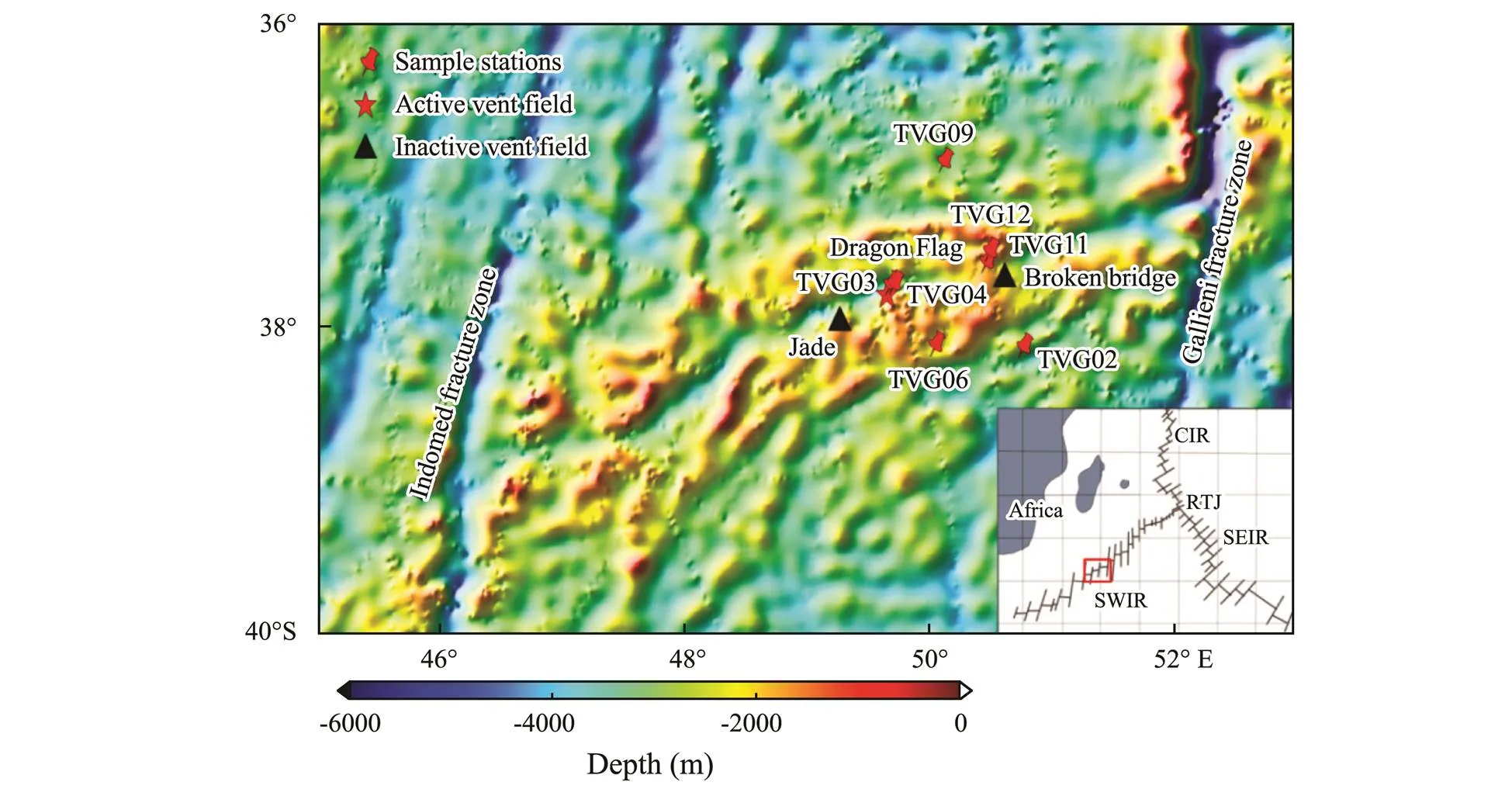
Fig.1 Bathymetric map of the study area and sample location in SWIR.
3 Sampling and Methods
The study region locates in the 49.6?E hydrothermal field in the SWIR (Fig.1). The surface sediment samples were acquired during the 34th cruise of the ‘
The pretreatment of the sediment samples and the mineral analysis method are as follows.
1) Sample pretreatment
Before the X-ray analysis, we pretreated the sediment samples by removing organic matter, separating the coarse and fine sediments, and removing the calcite. We selected suitable amounts of sediment samples, placed them in separate beakers, added 30% H2O2, stirred them homoge- nously and left them stationary for 12h. We repeated these steps until complete removal of the organic matter. We then added deionized water with sufficient stirring and cen- trifuged the solution using a 4000rmin?1centrifuge for 30min. We repeated this procedure 6 times and then collected the samples for later use. We then used 0.063mm sieves to separate the coarse and fine sediments, separately collected the samples from above and below the sieves, and centrifuged and concentrated the samples below the sieves for later use.
We used acetic acid to remove the carbonate minerals. We placed the samples to be treated in centrifuge bottles, added enough 20% acetic acid, placed the bottles in a water bath tank at a constant temperature of 27℃, and vibrated them for 12h. We repeated these steps once, recycled the samples, and baked them dry for later use. To distinguish the types of clay minerals, we also pre-treated the samples through the ethylene glycol saturation treatment.

Table 1 Information about surface sediment samples from the 49.6?E hydrothermal field in the SWIR
We conducted X-ray diffraction (XRD) analysis on the 3 types of samples, which include the bulk fine-grained sediment (less than 0.063mm) samples, the residuals after calcite removal, and the residuals after ethylene glycol saturation treatment.
2) X-ray diffraction analysis
We used the X-ray powder diffraction method to conduct the mineral phase analysis of the sediments. The XRD instrument was a Bruker D8 ADVANCE diffraction meter produced by Bruker, Germany. The diffraction con- ditions included a copper target, 40kV tube voltage, 100mA tube current, 0.02? step size for the goniometer (2), 4? min?1scanning speed, and scanning range of 3?–65?. The measurement results were analyzed by using the Jade 5.0 software. The accuracy error of XRD measurement is less than 5%.
4 Results
4.1 Mineral Compositions of the Bulk Samples of the Fine-Grained Sediments
The bulk samples of the fine-grained sediments mainly consisted of calcite and quartz. The dominant mineral component was calcite, followed by quartz (Fig.2). This is con- sistent with the high CaCO3content calculated by using the acetic acid consumed to remove the calcareous content (Table 1). Microscope observations can find calcareous shells, such as foraminifera. Combined with the sea-water depth in this region, we inferred that large amounts of calcareous bioclastics are preserved because the SWIR is above the carbonate compensation depth (CCD). Because of the ‘dilution effect’ of calcite, clay minerals and feldspar that are commonly found in oceanic environments are below the detection limit of the X-ray diffractometer and do not appear in the XRD spectra.
4.2 Mineral Composition of the Residuals After Removal of the Calcareous Component
Twelve minerals were detected after removal of the calcareous component (Fig.3). We estimated the relative content of each mineral using K value method (Table 2). Quartz and plagioclase constitute 40%–65% of the total mineral content and are the major minerals in this region. The clay minerals include montmorillonite, kaolinite, illite, chlorite, and make up 26%–51% of the mineral content, which is the second highest in the samples. The serpentine, magnetite, and pyroxene percentages range from 5% to 10%. The percentages of sphalerite and barite are 2%– 7%, which are the lowest in the sediments from this region.
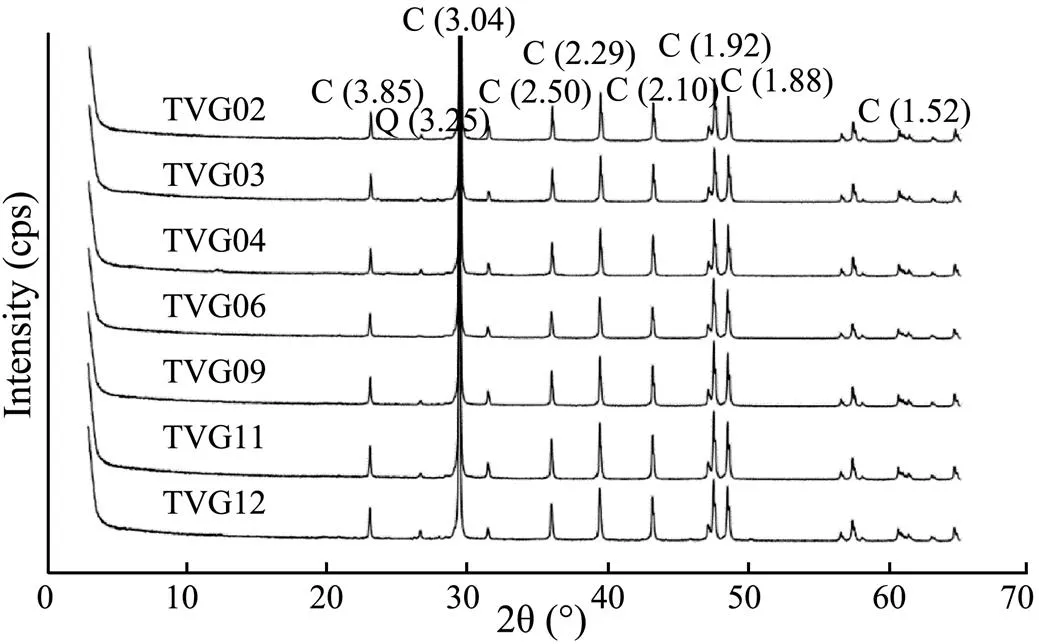
Fig.2 XRD diffraction spectra of the bulk samples of the fine-grained sediments. C, calcite diffraction peaks; Q, qu- artz diffraction peaks.

Fig.3 XRD diffraction spectra of the fine-grained sediments after removal of the calcareous component. Q, quartz; Pl, plagioclase; Py, pyroxene; Serp, serpentine; I, illite; K, kaolinite; Ch, chlorite; Sm, montmorillonite; Sph, sphale- rite; Ma, magnetite; Ba, barite; Non, nontronite.
The mineral compositions differ significantly between the samples from different stations. Quartz, plagioclase, montmorillonite, kaolinite, illite, pyroxene, and chlorite are found at all the samples, while sphalerite, serpentine, nontronite, barite, and magnetite are only found in the se- diments at some stations.
The two samples that are closest to the Dragon Flag hydrothermal vent site (TVG03 and TVG04) contain the most abundant mineral phases.
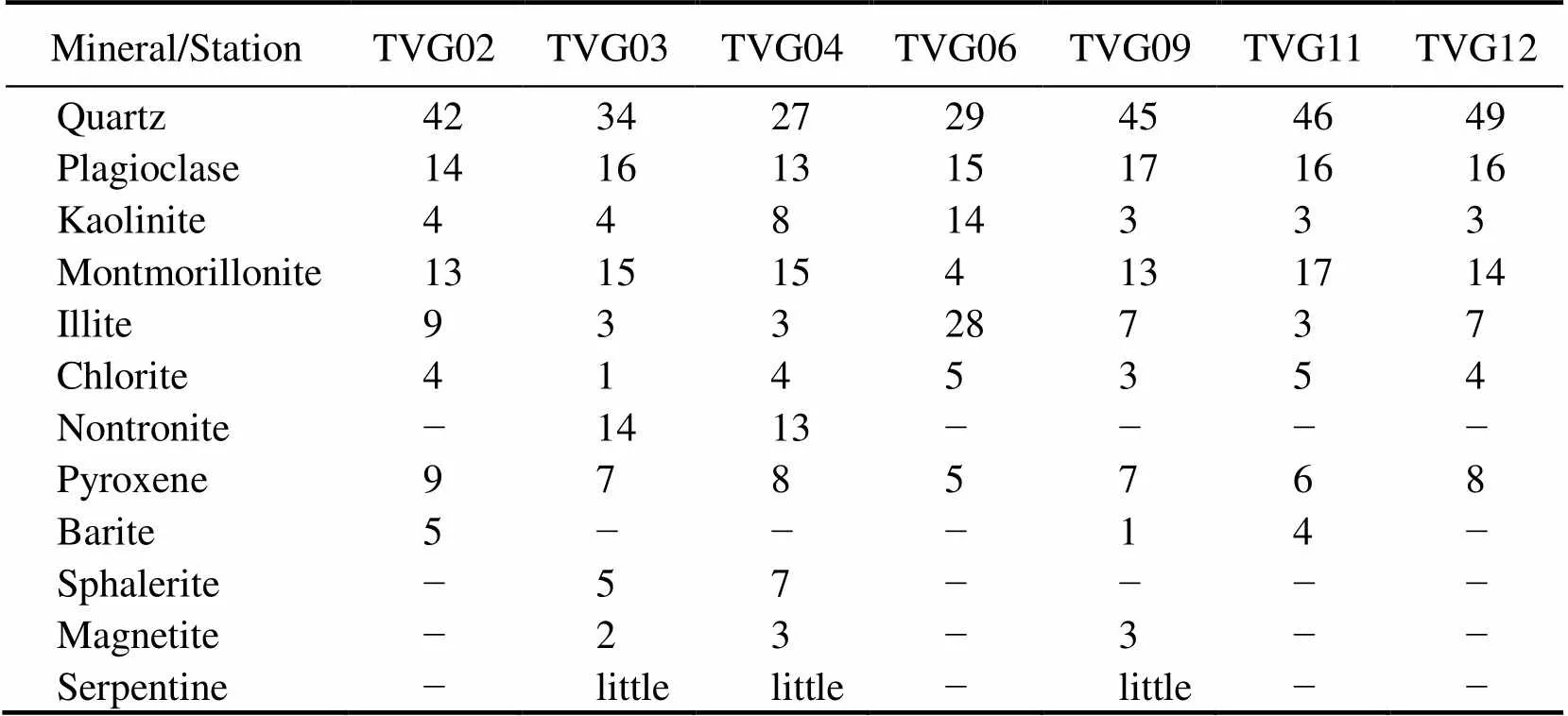
Table 2 Minerals contents of the sediments after removal of the calcareous content (%)
Notes: The serpentine diffraction peaks are weak, so we did not calculate its content. ‘?’ indicates not detected.
To distinguish expansive clay minerals, we conducted an XRD analysis to the samples saturated with ethylene glycol. The results are shown in Fig.4. The diffraction peaks (d value) used for distinguishing smectite, illiete, and kaolinite+chlorite are 17?, 10?, and 7.1?, respecti- vely. We calculated the relative contents of the clay minerals based on the revised Biscay method. The results are shown in Table 3.
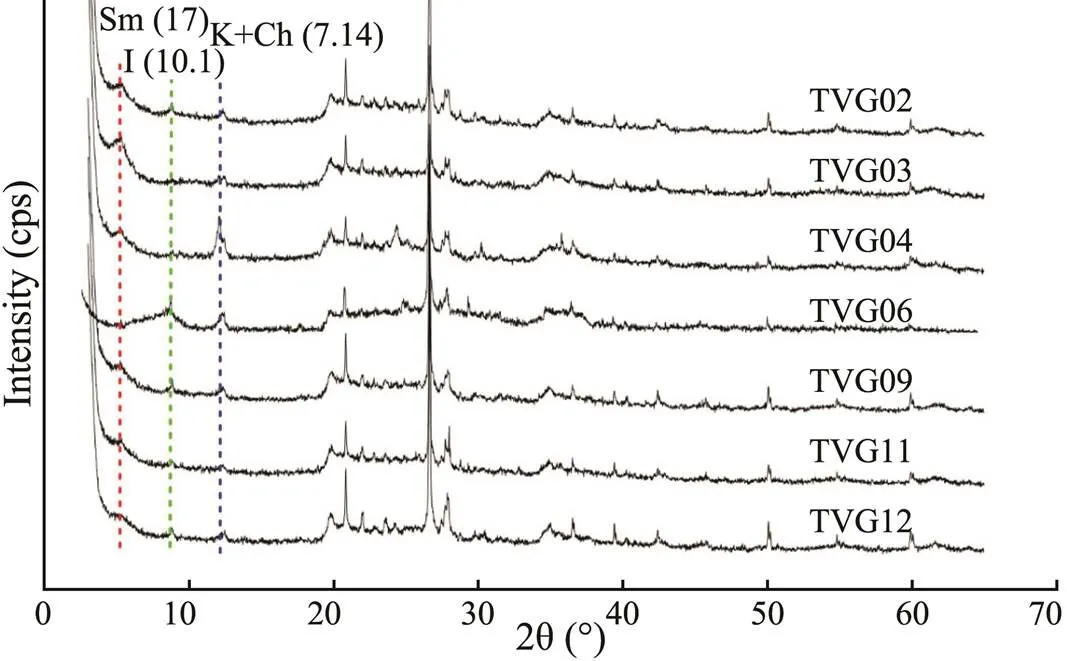
Fig.4 XRD diffraction spectra of the calcareous-removed sediments after ethylene glycol saturation treatment. I, illite; K, kaolinite; Sm, montmorillonite; Ch, chlorite.
In general, illite is the main clay mineral phase (63%). The sediments from two stations closest to the hydrother- mal vent have low illite contents. The kaolinite contents are generally higher than the chlorite contents.
5 Discussion
5.1 Mineral Sources of the Surface Sediments
5.1.1 Clay minerals
All 7 samples contain clay minerals, which indicate that the clay minerals are ubiquitous. Previous studies showed that the seafloor clay minerals were mainly from seafloor base-rock weathering, continental aeolian sources, and hydrothermal sources directly deposited from hydrothermal fluids (Weaver, 1989). The 49.6?E hydrothermal field in the SWIR occurs basalt as seafloor base-rock and the Dragon Flag hydrothermal vent. Also it is close to southern Africa and Antarctica continents. All of them are the possible sources of clay minerals in this region.
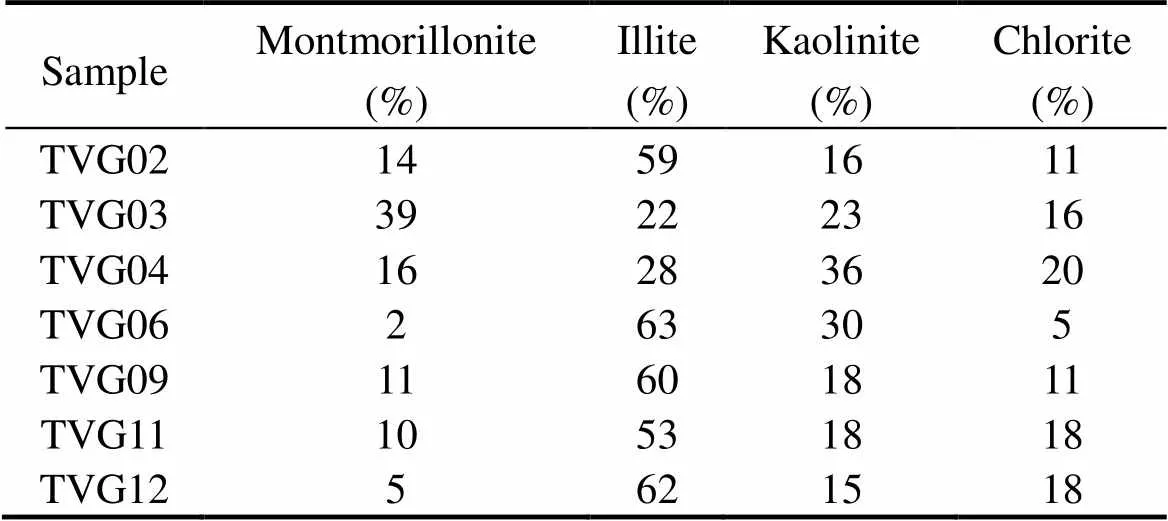
Table 3 Relative contents of clay minerals in the samples after ethylene glycol saturation treatment
The comparison of the clay mineral assemblages from the different sources shows that the clay mineral assemblage from the 49.6?E hydrothermal field falls in two areas. The first area (dark blue triangles) determined by most samples is near the aeolian clay assemblage of southern Africa. The second area (red stars) is located immediately below the first clay mineral assemblage. The first clay mineral assemblage in this region may mainly originate from the aeolian deposits from the Namib and Kalahari deserts of southern Africa. The clay minerals from the Sahara Desert in northern Africa, which is the largest desert in the world, do not affect this region. Similarly, the clay mineral assemblages in the deserts of Australia and South America are quite different from the clay mineral assemblage in the 49.6?E hydrothermal field. So they do not affect this region.
The second type of clay mineral assemblage is only found at the two stations closest to the Dragon Flag hy- drothermal vent: TVG03 and TVG04. The assemblage is consistent with the hydrothermal clay mineral assemblages from the Juan de Fuca Ridge in the Pacific, which all have very low illite contents and contain nontronite (Hri- scheva and Scott, 2007). These two samples also contain sulfide minerals. These features indicate that the second type of assemblage also contains clay minerals formed by seafloor hydrothermal activities in addition to the aeolian source from African deserts.
Kolla. (1980) reported that the terrigenous materials from Antarctica that are carried by the Antarctic bottom water could reach the Mozambique region in the southwest Indian Ocean. Fig.5 also shows that besides the aeolian dust from the Namib and Kalahari deserts, the bottom clay mineral assemblage in the offshore region of An- tarctica is generally similar to the clay mineral assemblage in the area of the 49.6?E hydrothermal field. Therefore, we infer that the bottom sediments from offshore Antarctica also contributed some clay minerals to this region, but the contribution is less than that of the aeolian dust from the Namib and Kalahari deserts. Similarly, the diffusion paths of the deep water of the southern Atlantic Ocean in the southwest Indian Ocean are completely controlled by the basin topography (Mantyla and Reid, 1995). This study region is located on the Crozet Plateau; thus, the deep water from the southern Atlantic Ocean will not affect the clay mineral assemblage. Fig.5 also shows that the clay mineral assemblage of the southern Atlantic Ocean is quite different from that of this region.
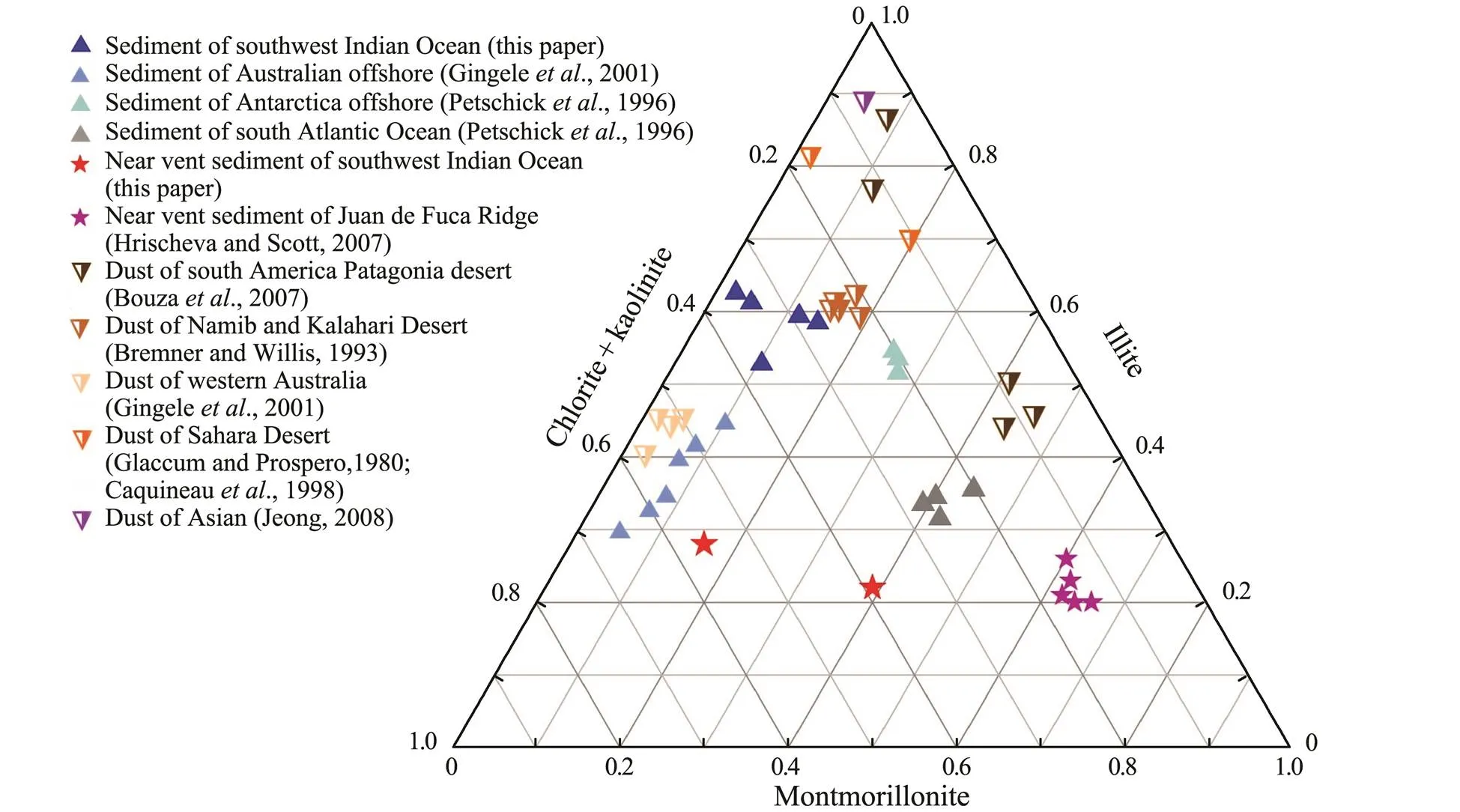
Fig.5 The compositions of clay minerals in SWIR and possible sources.
5.1.2 Terrigenous detrital materials
Based on the analysis of the clay minerals, we suggest that the main source of the terrigenous clastic materials are the aeolian dusts from southern Africa as well as materials carried by the Antarctic bottom flow.
Quartz grains are very stable under different types of surface environments and cannot form via the weathering of the basic oceanic crust. The ubiquitous quartz mineral grains in this region were mainly transported by the wind. Aeolian dust from southern Africa is the main source of the terrigenous clastic in this region. In addition, Ellis (1980) found large amounts of quartz minerals in the gra- nulite at Enderby, Antarctica. Combined with the effect of the Antarctica bottom water, we infer that the quartz in this region may also include the weathering products from Antarctica.
The plagioclase content is second only to quartz. Plagioclase can originate from mineral dust of terrigenous materials and from the weathering of the seafloor base rocks. Because the spatial distribution of the plagioclase clastic content is stable (Table 2) and it is closely associated with quartz, we infer that the plagioclase clastic are also mainly derived from aeolian inputs.
5.1.3 Seafloor weathering clastic of basement rocks
At the mid-ocean ridge in the study region rocks are young. The basement rocks are widely exposed, and the weathering and alteration of the basement rocks can generate detrital minerals and clay minerals (Bouza., 2007). The study of the basement rocks in the SWIR by Zhou and Dick (2013) showed that most are basalts except for occasional peridotite in fractures. Yu. (2013) conducted a petrologic study to basalts collected from the 49.6?E hydrothermal field and found that the main rock- forming minerals were olivine, pyroxene, and plagioclase. All of the sediment samples from this region contained pyroxene grains. The potential weathering index of pyroxene is high, and pyroxene is difficult to be preserved under continental weathering environments. Therefore, the pyroxene in this region should be from seafloor detrital materials of basement rocks or the weathering residues.
Of the 7 samples from this region, three contained serpentine, which is associated with sphalerite. Because the SWIR is an ultra-slow spreading ridge with an insufficient magma supply, serpentinization is an important heat source. The photos from the seafloor towed camera and the basement rock samples all showed the occurrence of serpentinization. Hence, we infer that the serpentine in this region is the product of serpentinization of basement peridotite and enters the sediments through seafloor wea- thering. Magnetite is a ubiquitous mineral in serpentinite that is a product of the serpentinization reaction for the iron endmember of olivine. In the 7 samples from this re- gion, the presence of magnetite is very well correlated with the presence of serpentine (Table 2). Thus, we suggest that the source of the magnetite is the same as that of the serpentine. Magnetite is also the seafloor weathering products of serpentinized basement rocks.
5.1.4 Sulfide and sulfate
The 49.6?E hydrothermal field contains the Dragon Flag hydrothermal vent. Hydrothermal products, which are mainly polymetallic sulfides, are scattered from upwelling plumes and neutral plumes to the sediments in the surrounding region. Ye. (2011) and Tao. (2011) each conducted systematic mineralogical studies of the massive sulfides and chimneys in this region, and both studies found sphalerite. Of the 7 samples from this region, only samples TVG03 and TVG04, which are closest to thehydrothermal vent, contained sphalerite. Therefore, we con- clude that the sphalerite in this region is from the Dragon Flag hydrothermal site.
Generally, marine barite has three genesis types: biogenic deposit, terrigenous input, and hydrothermal product. Barite is a common authigenic mineral in marine en- vironments and is considered to be closely related to the microenvironment formed by the decay of organic matters. It is also considered to be a good alternative index of oceanic primary productivity. The samples from the stations close to the hydrothermal vent do not contain barite. Ye. (2011) did not find barite in the massive sulfide deposits. Sun (2011) found that barite was ubiquitous in the water in this region and suggested that it is closely related to biological activities. Therefore, we infer that the barite in the sediments from this region is not from the seafloor hydrothermal activities but rather from marine authigenic deposits.
In addition, the calcite contents of the bulk samples of the fine-grained sediments are generally higher than 90% (Table 1). Microscope and SEM observations found large amounts of foraminifera and coccolith clastics, which both include calcite shells. Therefore, calcareous biological debris is the major mineral phase of the surface sediments in this region.
Based on the analysis of the mineral sources, we categorize the sources of the fine-grained sediments in the 49.6?E hydrothermal field in the SWIR as endogenous sources and exogenous inputs.
Endogenous sources: the minerals are produced by the weathering of seafloor basement rocks, hydrothermal activities, and biological processes. They enter the sedimentsthrough endogenous deposition and settling. The main mi- nerals are pyroxene, sulfide, serpentine, magnetite, some clay minerals, calcite, and barite.
Exogenous inputs: the minerals are mostly from the deserts in southern Africa and a few from Antarctic continent. They are transported to this region by the southern Africa monsoon and the Antarctica bottom flow. These minerals primarily include quartz, feldspar, and clay minerals.
Based on the previous calculations of mineral contents (Table 2), we estimate that the majority of the minerals are exogenous while the minority of them are endogenous.
5.2 Implications for the Seafloor Hydrothermal Activity in this Region
Because of their different geological backgrounds, in different hydrothermal fields, the hydrothermal properties and products are different, which lead to different mineral assemblages in the corresponding polymetallic deposits. Table 4 summarizes the mineral compositions of the metalliferous sediments in the hydrothermal fields on the Mid- Atlantic Ridge (MAR), Southwest Indian Ridge (SWIR), East Pacific Ridge (EPR), Central Indian Ridge (CIR), andJuan de Fuca Ridge of the Northeast Pacific ridge (ENPR).
In summary, the minerals in the surface sediments near the modern seafloor hydrothermal fields consist of clay minerals+sulfide minerals+other debris minerals. The pro- portions of clay minerals and debris minerals (quartz and feldspar) increase with increasing distance from the hy- drothermal vent, while sulfides are only present near the vents. Previous researches have suggested that the hydrothermal components in deep-sea sediments were mainly from three sources: 1) near-vent debris, 2) particles settling from the plumes, and 3) deposits from near-vent diffu- sive discharges. The sulfide clastics near the vents are parti- cles that were deposited from upwelling plumes. Hris- cheva and Scott (2007) first classified polymetallic sediments as upwelling plume particles near vents and neutral plume particles at ridge flanks. We categorize the hydrothermal component in the deep-sea sediments into two classes according to their discharge paths: plume deposition and diffusive fluid deposition.
Koschinsky. (2002) studied the low-temperature hydrothermal diffusive systems in the northern Fiji basin and found that the hydrothermal sediments collected from regions surrounding extinct hydrothermal vent communities contained abundant metal elements (., 29% S, 26% Fe, 10% Zn, and 3.6% Cu), while the hydrothermal sediments collected from regions surrounding active hydrothermal vent communities had extremely low metal contents (., Zn and Cu≤0.1%). Furthermore, the former contained fewer sulfide particles because of low fluid temperatures. In mid-ocean ridge systems with fractures, such as the southwestern Indian Ridge (Muller., 1999), the diffusive fluids mix with low-temperature alkaline seawater under the seafloor, and the sulfide deposited at the sub-seafloor. Lower metal concentrations are suitable for hydrothermal organisms. Koschinsky. (2002) also inferred that the diffusive fluids associated with active hydrothermal vent communities had the low metal concentrations due to the deposition of metal sulfides under the seafloor. Compared with the large amount of direct sulfide deposition from the plume, only a small amount of fine-grained sulfides were carried out of the seafloor by the diffusive fluids. Huang (2010) confirmed the existence of flourishing biological communities around the Dragon Flag hydrothermal field in the SWIR, which indirectly confirmed that the metal concentrations in the diffusive fluids in the region of this study were low and that the sulfide minerals were deposited under the seafloor. Thus, we suggest that the sulfide particles in the sediments at the mid-ocean ridge in the southwest Indian Ocean are mainly from plume deposition. In addition, heat flow data have shown that 50%–90% of the heat of hydrothermal activity is released through diffusive flow (Bemis., 2012).

Table 4 Mineral compositions of the polymetallic deposits in different hydrothermal fields
6 Conclusions
We found 13 minerals in fine-grained fraction of surface sediments from the 49.6?E hydrothermal field in the SWIR. Calcite dominates the surface sediments, which alsocontain quartz, feldspar, clay minerals, pyroxene, sphalerite, barite, serpentine, and magnetite. Of the 13 types of minerals, the quartz, feldspar, and clay minerals are mainly from the Namib and Kalahari deserts in southern Africa and are exogenous input minerals, while the pyroxene, serpentine, magnetite, sphalerite, calcite, and barite are endogenous minerals.
Acknowledgements
The authors thank the crew of the‘for sampling during the cruises DY125, 26, and 34. This work was supported by the China Ocean Mineral Resources Research and Development Association (No. DY 125-11-R-04).
Aoki, S., Kohyama, N., and Hotta, H., 1996. Hydrothermal clay minerals found in sediment containing yellowish-brown ma- terial from the Japan Basin., 129: 331-336.
Bach, W., 2002. Discovery of ancient and active hydrothermal systems along the ultra-slow spreading Southwest Indian Ridge 10?–16?E., 3: 1-15.
Baker, E. T., and German, C. R., 2004. On the global distribu- tion of hydrothermal vent fields. In:. German, C. R.,., eds., American Geophysical Union, Wa- shington, D. C., 245-266.
Beaulieu, S. E., Baker, E. T., and German, C. R., 2015. Where are the undiscovered hydrothermal vents on oceanic spreadingridges?,121: 202-212.
Bemis, K., Lowell, R. P., and Farough, A., 2012. Diffuse flow on and around hydrothermal vents at mid-ocean ridges.,25: 182-191, DOI: 10.5670/oceanog.2012.16.
Bode?, S., Buatier, M., Steinmann, M., Adatte, T., and Wheat, C. G., 2008. Characterization of metalliferous sediment from a low-temperature hydrothermal environment on the Eastern Flank of the East Pacific Rise., 250: 128-141.
Bouza, P. J., Simón, M., Aguilar, J., del Valle, H., and Rostagno, M., 2007. Fibrous-clay mineral formation and soil evolution in Aridisols of northeastern Patagonia, Argentina., 139: 38-50, DOI: 10.1016/j.geoderma.2007.01.001.
Bremner, J. M., and Willis, J. P., 1993. Mineralogy and geoche- mistry of the clay fraction of sediments from the Namibian continental margin and the adjacent hinterland., 115: 85-116.
Buatier, M. D., Monnin, C., Früh-Green, G. L., and Karpoff, A. M., 2001. Fluid-sediment interaction related to hydrothermal circulation in the eastern flank of the Juan de Fuca Ridge., 175: 343-360.
Caquineau, S., Gaudichet, A., Gomes, L., Magonthier, M., and Chatenet, B., 1998. Saharan dust: Clay ratio as a relevant tracer to assess the origin of soil-derived aerosols., 25: 983-986.
Dekov, V. M., Marchig, V., Rajta, I., and Uzonyi, I., 2003. Fe- Mn micronodules born in the metalliferous sediments of two spreading centres: The East Pacific Rise and Mid-Atlantic Ridge., 199: 101-121.
Dias, á. S., and Barriga, F. J. A. S., 2006. Mineralogy and geo- chemistry of hydrothermal sediments from the serpenti- nite- hosted Saldanha hydrothermal field (36?34?N; 33?26?W) at MAR., 225: 157-175.
Ellis, D. J., 1980. Osumilite-sapphirine-quartz granulites from Enderby Land, Antarctica: P-T conditions of metamorphism, implications for garnet-cordierite equilibria and the evolution of the deep crust., 74: 201-210, DOI: 10.1007/BF01132005.
Fouquet, Y., and Rona, A., 1993. New age data for Mid-Atlantic Ridge hydrothermal sites: TAG and Snakepit chronology re- visited., 98 (B6): 9705-9713.
Gingele, F. X., De Deckker, P., and Hillenbrand, C. D., 2001. Clay mineral distribution in surface sediments between In- donesia and NW Australia–Source and transport by ocean currents., 179: 135-146, DOI: 10.1016/S00 25-3227(01)00194-3.
Glaccum, R. A., and Prospero, J. M., 1980. Saharan aerosols over the tropical North Atlantic–Mineralogy.,37: 295-321.
Han, C. H., Wu, G. H., and Ye, Y., 2015. Geochemical methods of sediment for using in exploration of submarine polymetallic sulfide.. Changchun.
Hannington, M., Jamieson, J., Monecke, T., Petersen, S., and Beaulieu, S., 2011. The abundance of seafloor massive sulfide deposits., 39: 1155-1158, DOI: 10.1130/G32468.1.
Herzig, P. M., and Pluger, W. L., 1988. Exploration for hydro- thermal activity near the Rodriguez triple junction, Indian Ocean., 26: 721-736.
Hrischeva, E., and Scott, S. D., 2007. Geochemistry and mor- phology of metalliferous sediments and oxyhydroxides from the Endeavour segment, Juan de Fuca Ridge., 71: 3476-3497.
Hrischeva, E., Scott, S. D., and Weston, R., 2007. Metalliferous sediments associated with presently forming volcanogenic massive sulfides: The SuSu knolls hydrothermal field, eastern manus basin, Papua New Guinea., 102: 55-73.
Huang, D. S., Zhang, X. Y., Zhang, G. Y., Tao, C. H., and Li, H. M., 2016. Geochemical characteristics of sediments in South- west Indian Ridge 48.6?–51.7?E., 35 (1): 22-29 (in Chinese with English abstract).
Huang, D. Y., 2010. Preliminary studies on the benthos from deep-sea hydrothermal fields in Lau Basin of Southwest Pacific and Southwest Indian Ridge. PhD thesis. Third Insti- tute of Oceanography, State Oceanic Administration.
James, R. H., Green, D. R. H., Stock, M. J., Alker, B. J., Banerjee, N. R., Cole, C., German, C. R., Huvenne, V. A. I., Powell, A. M., and Connelly, D. P., 2014. Composition of hydrothermal fluids and mineralogy of associated chimney material on the East Scotia Ridge back-arc spreading centre., 139: 47-71.
Jeong, G. Y., 2008. Bulk and single-particle mineralogy of Asian dust and a comparison with its source soils., 113: 1-16.
Jia, Q., Fan, D., Zhang, W., Sun, X., Liu, M., and Yang, Z., 2017. Sulfide mineralogy of surface sediments of the southwestern Indian Ridge and its geological implication., 37 (6): 725-736 (in Chinese with English abstract).
Kato, Y., Fujinaga, K., Nakamura, K., Takaya, Y., Kitamura, K., Ohta, J., Toda, R., Nakashima, T., and Iwamori, H., 2011. Deep-sea mud in the Pacific Ocean as a potential resource for rare-earth elements., 4: 535-539.
Kolla, V., Kostecki, J. A., Henderson, L., and Hess, L., 1980. Morphology and Quaternary sedimentation of the Mozambique Fan and environs, southwestern Indian Ocean., 27: 357-378.
Koschinsky, A., Seifert, R., Halbach, P., Bau, M., Brasse, S., De Carvalho, L. M., and Fonseca, N. M., 2002. Geochemistry of diffuse low-temperature hydrothermal fluids in the North Fiji Basin., 66: 1409-1427.
Lalou, C., Reyss, J. L., Brichet, E., Rona, P. A., and Thompson, G., 1995. Hydrothermal activity on a 105-year scale at a slow spreading ridge, TAG hydrothermal field, Mid-Atlantic Ridge 26?N., 100: 17855-17862.
Laurila, T. E., Hannington, M. D., Leybourne, M., Petersen, S., Devey, C. W., and Garbe-Sch?nberg, D., 2015. New insights into the mineralogy of the Atlantis II Deep metalliferous se- diments, Red Sea., 16 (12): 4449-4478.
Laurila, T. E., Hannington, M. D., Petersen, S., and Garbe-Sch?n- berg, D., 2014. Early depositional history of metalliferous sediments in the Atlantis II Deep of the Red Sea: Evidence from rare earth element geochemistry., 126: 146-168.
Li, Z., Chu, F., Jin, L., Li, X., Dong, Y., Chen, L., and Zhu, J., 2016. Major and trace element composition of surface se- diments from the Southwest Indian Ridge: Evidence for the incorporation of a hydrothermal component., 35: 101-108.
Li, S. Z., Suo, Y. H., Yu, S., Zhao, S. J., Dai, L. M., Cao, H. H., Zhang, Z., Liu, W. Y., and Zang, G. Y., 2015. Morpho- tectonics and tectonic processes of the southwest Indian Ocean., 1: 15-29.
Mantyla, A. W., and Reid, J. L., 1995. On the origins of deep and bottom waters of the Indian Ocean., 100: 2417-2439.
Meylan, M. A., Glasby, G. P., Knedler, K. E., and Johnston, J. H., 2012. Metalliferous deep-sea sediments., 9: 77-178.
Moriyama, T., Miyawaki, R., Yokoyama, K., Matsubara, S., Hira- no, H., Murakami, H., and Watanabe, Y., 2011. Wakefieldite- (Nd), a new neodymium vanadate mineral in the arase strati- form ferromanganese deposit, Kochi Prefecture, Japan., 61: 101-110.
Muller, M. R., Minshull, T. A., and White, R. S., 1999. Segmen- tation and melt supply at the Southwest Indian Ridge., 27: 867-870.
Nayak, B., Halbach, P., Pracejus, B., and Münchd, U., 2014. Massive sulfides of Mount Jourdanne along the super-slow spreading Southwest Indian Ridge and their genesis., 63: 115-128.
Petschick, R., Kuhn, G., and Gingele, F., 1996. Clay mineral distribution in surface sediments of the South Atlantic: Sources, transport, and relation to oceanography., 130: 203-229.
Riley, J. P., and Chester, R., 2016.. Aca- demic press, London, 1-414.
Severmann, S., Mills, R. A., Palmer, M. R., and Fallick, A. E., 2004. The origin of clay minerals in active and relict hydro- thermal deposits., 68: 73- 88, DOI: 10.1016/S0016-7037(03)00235-7.
Shilov, V. V., Bel’tenev, V. E., Ivanov, V. N., Cherkashev, G. A., Rozhdestvenskaya, I. I., Gablina, I. F., Dobretsova, I. G., Narkevskii, E. V., Gustaitis, A. N., and Kuznetsov, V. Y., 2012. New hydrothermal ore fields in the Mid-Atlantic Ridge: Zenith-Victoria (20?08?N) and Petersburg (19?52?N)., 442: 63-69.
Sun, X. X., 2011. Study on the suspended particulate minerals in the water column in the Eastern Equatorial Pacific Ocean and hydrothermal active areas in the Southwest Indian Ocean. PhD thesis. Ocean University of China.
Tao, C., Lin, J., Guo, S., Chen, Y. J., Wu, G., Han, X., German, C. R., Yoerger, D. R., Zhou, N., Li, H., Su, X., and Zhu, J., 2012. First active hydrothermal vents on an ultraslow-sprea- ding center: Southwest Indian Ridge., 40: 47-50, DOI: 10.1130/G32389.1.
Tao, C. H., Li, H. M., Huang, W., Han, X. Q., Wu, G. H., Su, X., Zhou, N., Lin, J., He, Y. H., and Zhou, J. P., 2011. Mine- ralogical and geochemical features of sulfide chimneys from the 49?39?E hydrothermal field on the Southwest Indian Ridge and their geological inferences., 56: 2828-2838, DOI: 10.1007/s11434-011-4619-4.
Toner, B. M., Fakra, S. C., Manganini, S. J., Santelli, C. M., Marcus, M. A., Moffett, J. W., Rouxel, O., German, C. R., and Edwards, K. J., 2009. Preservation of iron (II) by carbon-rich matrices in a hydrothermal plume., 2: 197- 201.
Weaver, C. E., 1989. Clay, muds and shales. In:. Elsevier, Amsterdam, 1-819.
Wolfgang, B., Banerjee, N. R., Dick, H. J. B., and Baker, E. T., 2013. Discovery of ancient and active hydrothermal systems along the ultra-slow spreading Southwest Indian Ridge 10?– 16?E., 3 (7): 1-14.
Ye, J., Shi, X. F., Yang, Y. M., Liu, J. H., Zhou, G. F., and Li, N. S., 2011. Mineralogy of sulfides from ultraslow spreading Southwest Indian Ridge 49.6?E hydrothermal field and its metallogenie significance., 31 (1): 17-29 (in Chinese with English abstract).
Yu, M., Su, X., Tao, C. H., Wu, G. H., Li, H. M., and Lou, H. L., 2013. Petrological and geochemistry features of basalts at 49.6?E and 50.5?E hydrothermal fields along the Southwest Indian Ridge., 27 (3): 497-508 (in Chinese with English abstract).
Zhang, T., Lin, J., and Gao, J. Y., 2011. Interactions between hotspots and the Southwest Indian Ridge during the last 90 Ma: Implications on the formation of oceanic plateaus and intra-plate seamounts., 54: 1177- 1188, DOI: 10.1007/s11430-011-4219-9.
Zhou, H., and Dick, H. J. B., 2013. Thin crust as evidence for depleted mantle supporting the Marion Rise., 494: 195- 200, DOI: 10.1038/nature11842.
January 22, 2018;
May 24, 2018;
May 30, 2018
? Ocean University of China, Science Press and Springer-Verlag GmbH Germany 2020
E-mail: xiaoxias@ouc.edu.cn
E-mail: djfan@ouc.edu.cn
(Edited by Chen Wenwen)
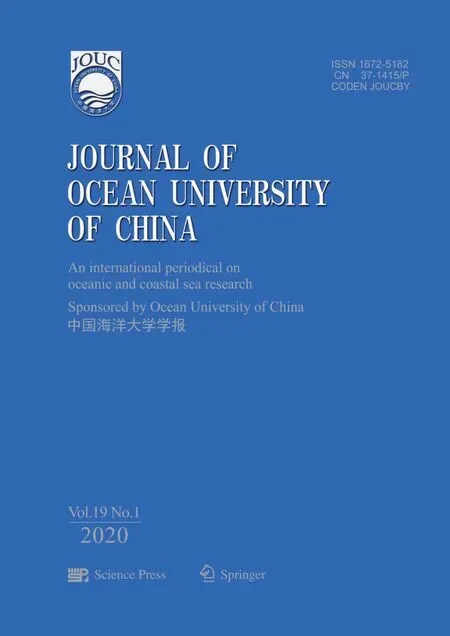 Journal of Ocean University of China2020年1期
Journal of Ocean University of China2020年1期
- Journal of Ocean University of China的其它文章
- Screening and Characterization of Nitrite-Degrading Bacterial Isolates Using a Novel Culture Medium
- Purification and Characterization of a Novel Lipase from Antarctic Krill
- Quality Assessment of Frozen Solenocera crassicornis Treated with Sodium Metabisulphite by Soaking or Spraying
- Contribution of Mesoscale Eddies to the Subduction and Transport of North Pacific Eastern Subtropical Mode Water
- Semi-Empirical Algorithm for Wind Speed Retrieval from Gaofen-3 Quad-Polarization Strip Mode SAR Data
- An Effective Method of Prompting Juvenile Rainbow Trout (Oncorhynchus mykiss) to Cope with Heat Stress
